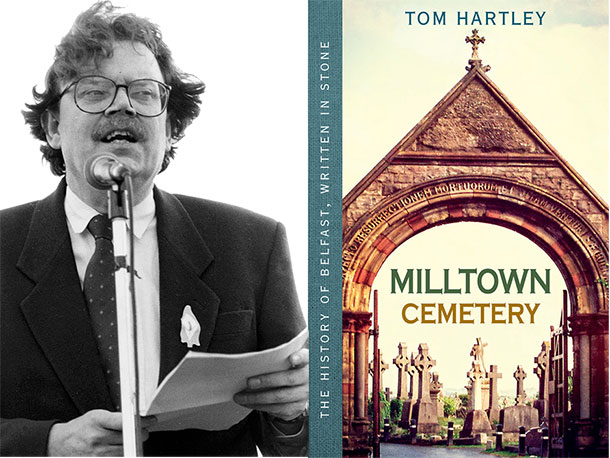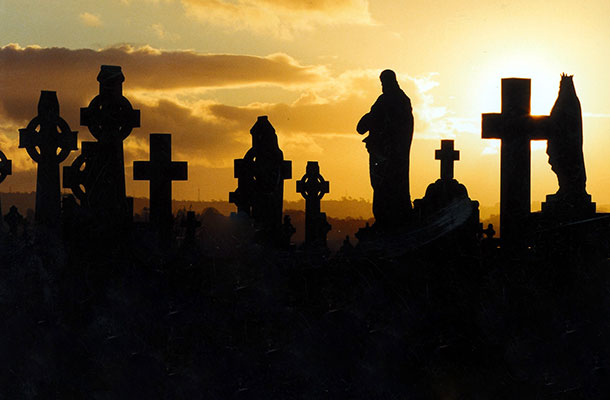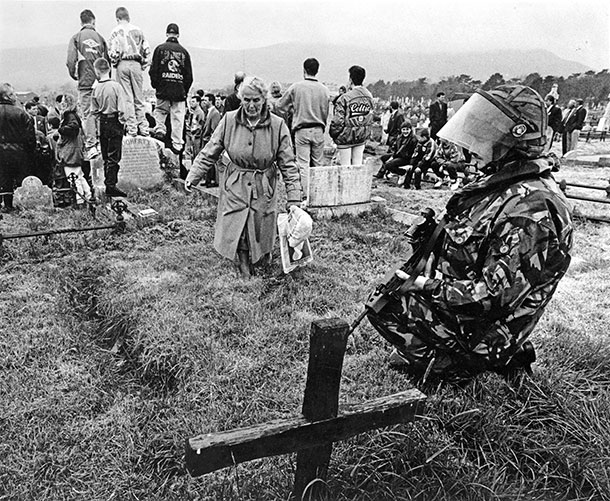12 January 2015 Edition
Milltown Cemetery, rich in people’s lives
Tom Hartley’s latest book in his series, History of Belfast, Written in Stone

• Tom Hartley speaks at an Easter commemoration in Milltown
Buried in Milltown are members of the British crown forces as well as republican activists. The author is a man with a strong republican background and it is to his credit that he treats all those buried there their stories with the utmost of respect.
GRAVEYARDS are history books in their own right, repositories of information and knowledge that informs the searcher and sheds light on times past. Belfast historian Tom Hartley’s new book on Milltown Cemetery reiterates that point, as did RTÉ’s recently-aired and acclaimed documentary on Glasnevin Cemetery, One Million Dubliners, featuring former An Phoblacht columnist, the late Shane Mac Thomáis.
In west Belfast’s Milltown Cemetery it could be argued, with real justification, that every blade of grass in the 150-year-old burial ground has its particular story to tell and can make its own claim on one of the many, many historical happenings connected with the place.
As publishers Blackstaff Press proclaim:
“Mill workers, labourers, clergy, Italian immigrants, victims of the Blitz, soldiers of the First and Second World Wars, political activists, IRA Volunteers, republicans, victims of ‘The Troubles” – Milltown’s graves are a historical record of the social, religious and political life of Belfast over two centuries.”
I’m someone who visits Milltown on a regular basis, mostly as a tour guide with the republican ex-prisoners’ organisation, Coiste na n-Iarchimí. Tom Hartley’s meticulous approach to research and cross-referencing has produced a masterpiece.

Buried in Milltown are members of the British crown forces as well as republican activists. The author is a man with a strong republican background and it is to his credit that he treats all those buried there their stories with the utmost of respect.
The irony that sees RIC members, killed by the IRA and buried close to IRA Volunteers who were killed in action through the years before and after partition, is part of Milltown’s historical tapestry that Hartley captures brilliantly.
One of those ironies captures the tale of Volunteer Tom Williams convicted and hanged for the killing of RUC Constable Patrick Murphy in 1942.
Murphy was buried in Milltown but it would be almost 60 years before Tom Williams’s remains, buried in the in Crumlin Road Prison, would be exhumed and reinterred in a family plot in 2000.
As Hartley points out: “Here the complexity of our history cannot go unnoticed.”
What the book also brings to the reader is the bloody reality of our history. The author highlights the story of the unionist pogroms of the 1920s – pogroms that were repeated down through the decades until the 1960s, when the burnings of Dover Street, Percy Street and Conway Street (all the way up to Bombay Street) brought nationalists to a point of no return and fuelled a resistance that brought Stormont crashing down and to where we are now.
Hartley also tells the story of Winifred Carney, describing her socialism and commitment to James Connolly before telling of her marriage to UVF man George McBride (he includes very detailed explanatory information on McBride and the UVF).

Such additional information and detail is an added bonus which fill in gaps in people’s knowledge, the story of the Fenian William Harbinson being a case in point for me.
Harbinson’s memory is marked on the McKelvey/Harbinson plot.
From Ballinderry, County Antrim, Harbinson served in the British Army but left. He was active in the Fenian movement and arrested on a number of occasions, the last being in 1867.
While awaiting trial in Crumlin Road Prison in September of that year, he died when an aneurysm ruptured. He was 36 years old.
In telling the story of Milltown, Hartley is at pains to point out that “the vast majority of people buried in Milltown are ordinary people but they lived through extraordinary times [they are] the mill workers, weavers and labourers of the working class”.
Alongside them are buried the priests and nuns who were part of the community and as Belfast’s Catholic population grew through the 19th and 20th centuries the influence of the Catholic Church grew with it.
Of the clergy buried in Milltown, the name of Fr Alec Reid stands out – a man of immense dignity and sincerity whose efforts in the pursuit of peace mark him out as a true champion of the people. His grave is in the Redemptorist Plot, located beside the Republican Plot.
In writing this book and telling the story of Milltown in this companion volume to his study of Belfast City Cemetery, Tom Hartley has chronicled the story of Belfast through its politics and the experiences of its people – the artists, the musicians, the architects and the sports people.
Milltown holds the graves of the famous and the not-so-famous but each grave tells a story. That Hartley has brought so many of those stories together, weaving them with our political and social history with such success, is a remarkable achievement.
• The History of Belfast, Written in Stone: Milltown Cemetery, by Tom Hartley, is published by Blackstaff Press. Price £12.99.




